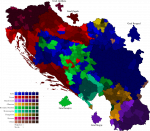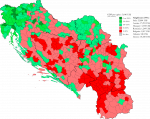[PS: I swear this is not my attempt at doing the latest American Dominion thing, but it draws from that. I was thinking of using SNTV as the electoral system because why not]
Political Parties in Columbia
Like in several other Anglophone countries (but markedly not the United Kingdom), the Columbian political cleavage is not clear-cut based on class. While the socio-economic, left-right axis matters a great deal, demographics are extremely important. And more than demographics, almost history matters as much, at least on the right: The losers of the Federalist Rebellion vs. its winners. West of the Ohio River, the People's Party is the main centre-right force, east of it, the National Progressive Party.
Columbia's old industrial working classes - mostly gone nowadays as a concept - were made up of recent arrivals, ethnic Columbians (Hiberno- and Italo-Columbians primarily), alienated from the Mayflower families [1] that dominated the NPP, who voted Labor. As a result, to this day, Labor draws primarily from the working class (now formed by recent arrivals) and 'white ethnic' Columbians who tend to be solidly middle-class. In western Columbia, where the PEC [2] Trinity and the number of Anglo-Columbians was reduced, politics evolved differently. Labor exists, and it's powerful in the main cities and in the mining valleys of the Appalachia, but there is a strong, Christian left, drawing from evangelical traditions and which drew support from Germano-Columbians and especially Nordic Columbians.
All this has contributed to the country's fractious politics, especially with the rise of the new left parties. Amidst all this, Columbian parties are not known for their ability to control their members, resulting in strong factionalism and parliamentary instability.
National Progressive Party: The party of the traditional upper classes of the country, economically centre-right and socially moderate (liberal-conservative or conservative liberal in European parlance), it is strong in rural New England, the Maritime Provinces, Upstate New York (OOC: Need a proper TTL name for this) and Pennsylvania. It also draws support from middle- and upper-middle urban people from eastern Columbia, and the well-off west of the Ohio River.
Laborers' Party (Labor): Labor is the party of the trade unions, ethnic Columbians and the urban working class. It is the only major party that is able to draw significant support from both east and west Columbia. In eastern Columbia too, the party also receives the votes of the rural left.
Independents' League: A result of Columbia's long-standing love for independent, centrist candidates, the League is openly non-ideological and proudly unwhipped. As a result, it is home to a plethora of political views, but its support in suburbs and exurbs, as well as from the Jewish community means that most of the League's affiliated MPs are centrists or liberals.
People's Party: The party of the western right. Unlike the more secular NPP, the People's Party has stronger ties to religious organisations, drawing significant support from evangelical Christians. As a result, it's economically centrist but socially the most conservative party. It is also a supporter of stronger provincial autonomy, in the spirit of the Federalist Rebellion. Ethnically-speaking, it draws support from the rural middle class and in the cities from conservative Germano-Columbians and also a good chunk of the Anglo-Columbian and Scots vote.
Farmers’ Union: The Union is the smallest of the major parties, as it represents a weakening brand of politics - Rural left-wing radicalism. Heavily tied to the land reform and cooperative movement that was very strong during the first half of the 20th century, the party has constantly lost support over time and now it exists almost more a vehicle for Nordic Columbians and left-leaning Germano-Columbians. Its left-wing stance combined with ties with evangelical Christianity has made it the main voice of Afro-Columbians in major cities like Chicago or Richmond (OTL Detroit-Windsor).
Green Party: Founded in the 1970s, it's explicitly a brand of post-ethnic, post-materialist politics. A niche party, it is mostly supported by students and very left-wing people, given the party's eco-socialist stances.
Green Liberal Party: Created in 2011 as a splinter from the Green Party, the GLP brings together ecological politics with free-trade support and liberal economics. As a result, it draws its votes from yuppies. This means that while small, it is over-represented in major cities like New York, Philadelphia or Boston.
[1] Trying something different as a terminology for WASP.
[2] Presbyterian-Episcopalian-Congregationalist, again trying out terminology other than 'WASP'.








